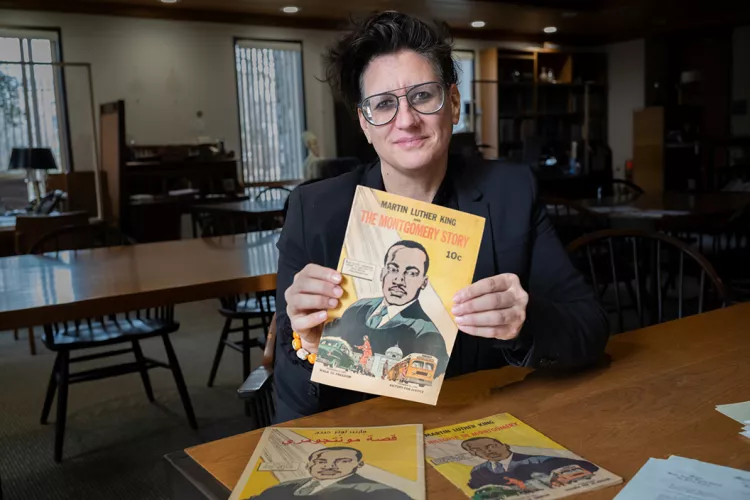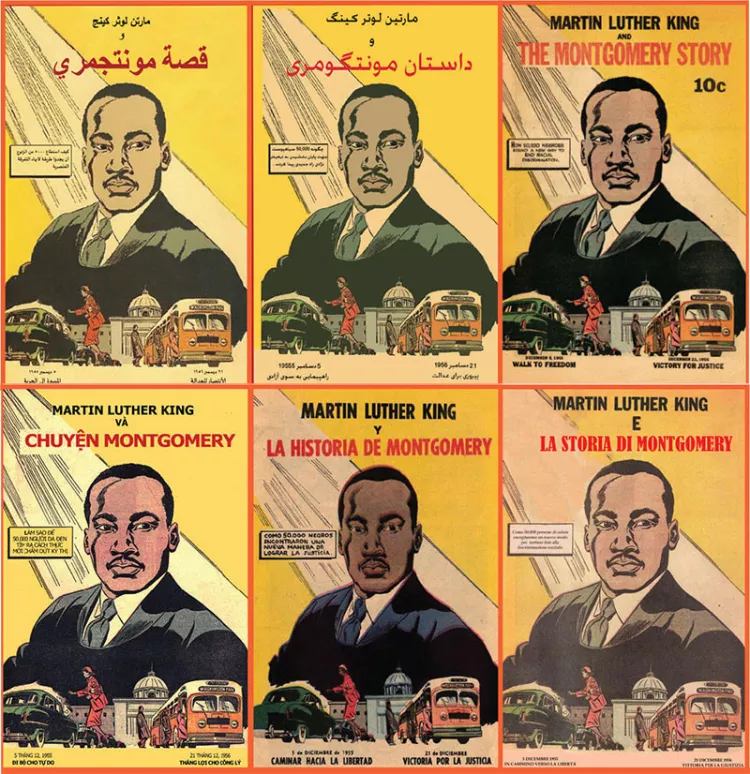Comic Book and Curriculum Guide Held at Swarthmore Continues Conversation on MLK and Effecting Change

“It’s great to see this rich history contextualized through such wonderful historical resources," says Rachel Mattson, who joined Swarthmore as director of special collections and George R. Cooley Curator of the Peace Collection in September.
The conversation on the Rev. Dr. Martin Luther King Jr. and the civil rights movement continues — and evolves — through a new resource available at Swarthmore.
The Peace Collection has long held a hidden gem: the 1957 comic book Martin Luther King and the Montgomery Story, which offers a compelling, if incomplete, account of the landmark bus boycott. But recently added to that is a curriculum and study guide geared toward educators, community leaders, and organizers.
“I was so excited to hear about both documents,” says Rachel Mattson, who joined Swarthmore as director of special collections and George R. Cooley Curator of the Peace Collection in September. “It’s great to see this rich history contextualized through such wonderful historical resources.”
The Fellowship of Reconciliation (FOR), whose papers are held in the Peace Collection, created the comic book 65 years ago to showcase how activists in Montgomery, Ala., used nonviolent direct action to fight segregation and white supremacy. The work has inspired the leaders of social movements from publication up to today; its Arabic translation was distributed to protesters at Cairo’s Tahrir Square in the first days of the Arab Spring, and the late U.S. Rep. John Lewis regularly cited the comic book, which he first read as a teenager in rural Alabama, as the “blueprint” for nonviolent direct action.
As powerful as the comic book has been, though, it has limitations. Reflecting the times in which it was written, it diminishes the essential role of women in the Montgomery movement, as well as that of a gay man, Bayard Rustin, who was integral to the widespread adoption of nonviolent civil disobedience philosophy and tactics in U.S. social movements.
The FOR created the curriculum and study guide in part to “repair and correct” these oversights, says Ethan Vesely-Flad, the organization’s director of national organizing and interim co-executive director.
“We hope that new generations who access this resource have a deeper context for the legacy of that groundbreaking grassroots movement and can see their own stories and social justice issues expressed more vividly and honestly,” says Vesely-Flad.

The comic has been published in six languages: English, Spanish, Vietnamese, Italian, Arabic, and Farsi.
One of the goals for the curriculum and study guide was to create materials that would “deepen, complicate, and supplement the text itself,” says educator Sarah DeBolt Badawi, who developed the materials in consultation with the FOR. The work needed to both capture the imaginations and push the thinking of K–12 students and create frameworks for thoughtful discussion and analysis for college-level students, adult learners, and community groups of different faith backgrounds.
“I wanted for people to be able to build on their experiences of activist work and connect themes raised in the comic book to those that social movements contend with to this day,” says Badawi.
Adds Mattson: “There are real connections between the aspirations people had in the mid-20th century to change the world around them and what we see people and movements striving for today,” noting the emphasis on Black Lives Matter in the curriculum and study guide.
The comic book and curriculum and study guide are “great tools to root our conversations about what we want and how we want to get it,” says Mattson.
The materials, including a Spanish translation of the comic book illustrated entirely anew, are also a natural fit at Swarthmore. Quakers helped organize the FOR in the early 20th century, and connections abound between the FOR and the College’s Special Collections, Friends Historical Library, and the Peace Collection.
“We’re really happy to showcase this work that connects our collections and our mission,” says Mattson, “and eager to help people to access these materials so they can use them to support their teaching and organizing work.”



